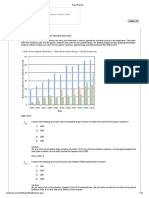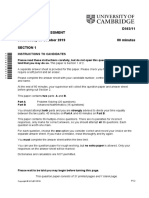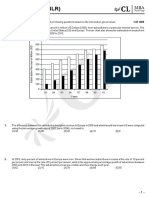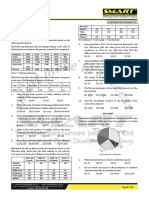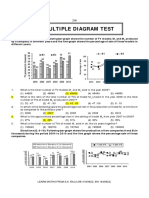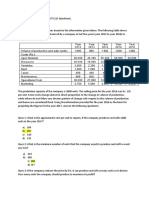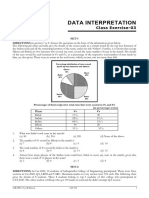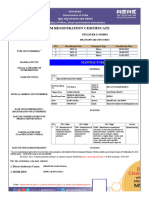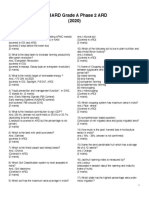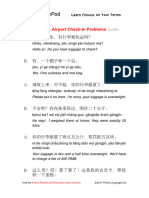DATA INTERPRETATION
Class Exercise-02
DIRECTIONS for questions 1 to 4: Answer the questions on the basis of the information given below.
In the production department of the company XYZ Ltd., there are ten’ machines - M1 through M10 - each of
which can produce widgets individually. However, due to general wear and tear, the time taken to produce a single
widget is not the same for all the machines. The following bar graph gives the respective times taken (in hours) by
the individual machines to produce one widget.
(hours)
6
5
4
3 3 3 3
2 2
1
M1 M2 M3 M4 M5 M6 M7 M8 M9 M10
Machine
Now, the production manager of the company has an option to rearrange some of the machines into groups such
that all the machines in a group simultaneously work on the same widget.
1. If due to the constraints of their present positions, the machines are grouped into pairs such that Ml is
grouped with M10, M2 with M9, M3 with M8 and so on, what is the minimum time (in hours) required by
any pair of machines to produce one widget?
5 6 8
(A) (B) (C)
6 5 5
12
(D) (E) None of the above
7
2. If a group of three machines operating together needs more than two hours to produce a widget, then how
many such distinct groups are possible?
(A) 1 (B) 2 (C) 3
(D) 4 (E) None of the above
3. If a group of two machines operating together produces three widgets in exactly four hours, which of the
following must be one of those two machines?
(A) M1 (B) M2 (C) M3
(D) M4 (E) None of the above
4. If each group can comprise at most two machines, then the number of widgets that can be produced in two
hours, by all the machines together, is at most
(A) 5 (B) 6 (C) 7
(D) 8 (E) None of the above
GRAPH-02 GP-301 1
�DIRECTIONS for questions 5 to 9: These questions are based on the following two graphs which represent the total
cost incurred and total sales earned by a company by selling two products A and B.
Note:
– The point at which the total cost of a product is equal to its total sales is called the “break-even” point.
– The costs which change with units of production are called variable costs and the costs which remain the
same for any number of units are fixed costs.
Total cost = Total fixed cost + Total variable cost
Total contribution = Total sales – Total variable cost
Profit = Total sales – Total cost
5. Find the average profit per unit of product A at the same level of production for which product B reached its
break-even point.
(1) Rs.50 (2) Rs.37.5 (3) Rs.25 (4) Rs. 0
6. How many units of each of the products A and B should be sold by the company to have break-even on the
whole?
(1) 200 (2) 250 (3) 300 (4) 360
7. If the selling prices per unit of the products A and B are interchanged, then what will be the total
contribution of product A at its original break-even point, other things remaining constant?
(1) Rs.50,000 (2) Rs. 10,000 (3) Rs. 15,000 (4) Rs. 12,500
8. At the end of one year, the company’s profit was Rs.8,00,000 of which, 46.25% was contributed by product
A. How many units of product B did the company sell in that year, given that every unit produced is sold?
(Assume that the graphs shown to continue the straight line trends they follow above indefinitely)
(1) 9000 (2) 90,000 (3) 900 (4) Can’t be determined
9. The finance manager of the company, while making a sensitivity analysis of the cost structuring was
contemplating the situation where in the fixed cost of the two products - A and B, increased by Rs. 10,000
each. If other values remain constant, then at what level of sales (in units) will the contribution of the product
A be twice its fixed cost?
(1) 1,600 (2) 2,400 (3) 4000 (4) 800
DIRECTIONS for questions 10 to 14: Answer these questions on the basis of the information given.
The following graph and table give information regarding the sales of mobiles by the company SMS and the total
market sales of mobiles during the period 2005 to 2014.
GRAPH-02 GP-301 2
� Total market sales Average selling price per mobile
Year of mobiles of the company SMS
(Rs. Crore) (Rs.)
2005 1600 4000
2006 2500 5000
2007 2000 3000
2008 4000 2500
2009 4800 3200
2010 4000 2400
2011 4500 3000
2012 3000 3200
2013 4000 4000
2014 5000 5000
Note: The company SMS sells only mobiles.
10. If in the year 2011, the sales of the mobiles of SMS form 25% by volume of the total market sales of mobiles,
what is the average selling price per mobile of all the other companies together in that year?
(1) Rs.200 (2) Rs.1500 (3) Rs.2000 (4) Cannot be determined
11. In how many of the years from 2006 to 2014, did the value of the sales of the mobiles of SMS increase and
the profit of SMS decrease over the previous year?
(1) less than 5 (2) 5 (3) 6 (4) more than 6
12. The ratio of the profit earned by SMS in the year 2010 to that in 2014 is
(1) 5 : 4 (2) 7 : 6 (3) 8 : 9 (4) 9 : 10
13. If the percentage share by volume of the sales of the mobiles of SMS in the total sales of the market grew by
10 percentage points from 2008 to 2009, find the percentage change in the total volume of sales of mobiles in
the market from 2008 to 2009.
(1) 20% increase (2) 25% decrease (3) 20% decrease (4) Cannot be determined
14. If in any year, the average selling price per mobile in the total market is less than that of the mobiles of SMS,
then in at least how many of the given years was the market share by volume of SMS less than 50% of the
total market?
(1) 4 (2) 5 (3) 6 (4) 7
GRAPH-02 GP-301 3
�DIRECTIONS for questions 15 to 19: Answer these question on the basis of the information given.
The following graph gives the percentage of young people and middle-aged people in the four regions of a state, as
a percentage of the total population of the respective region.
45
40
40
35 35
35
30 30 30
Percentage 30
25
25
20
20
15
10
5
0
North East West South
Region
Young People Middle-aged People
Note: The population is classified into people of only three age groups - young people, middle-aged people and
old people.
15. If the number of old people in the Southern region exceeds the number of old people in the Eastern region
by 20%, by approximately what percentage does the number of young people in the Southern region exceed
that in the Eastern region?
(1) 661/6% (2) 862/3% (3) 961/6% (4) Cannot be determined
16. If the total population of the Western region is 20% more than that of the Northern region, the number of
middle-aged people in the Northern region forms what percentage of the number of old people in the
Western region?
(1) 161/6% (2) 331/3% (3) 55% (4) Cannot be determined
17. If the number of middle-aged people in each of the four regions is the same, then the number of young
people is the greatest in the
(1) Northern region. (2) Eastern region. (3) Western region. (4) Southern region.
18. If the respective number of young people in the Northern, Eastern, Western and the Southern regions are in
the increasing order and the number of old people in these regions are denoted by a, b, c and d respectively,
then which of the following is always true?
(1) a < b (2) b < c (3) c < d (4) None of these
19. If the total population of the Northern and the Western regions put together is equal to that of the Eastern
and the Southern regions put together, and x is the total middle-aged population in the Northern and
Western regions put together and y is the total middle-aged population in Eastern and Southern regions put
together, then which of the following is always true?
(1) x = y (2) x > y (3) x < y (4) None of these
DIRECTIONS: for questions 20 to 23:
Six friends - Anupam, Bhaarat, Peter, Kartik, Gunjan and Ramit - availed a new SMS offer, according to which
there will be no charges for the SMSs sent or received within the group. The following pie charts pertain to the
details regarding the number of SMSs sent by these persons within the group during the month of October.
The first pie chart gives the break-up of total number of SMSs received by Anupam from his five friends in
October according to the friend from whom he received the SMSs and the second pie chart gives the break-up of
the total SMSs sent by these five persons within the group (i.e., excluding Anupam) in the same month according to
the person sending the SMSs.
GRAPH-02 GP-301 4
� Total = 3000 Total = N
Assume that SMSs sent are received instantly and also the number of SMSs sent by each person is always an integer.
For all the following questions, consider only the SMSs sent by the persons within the group in the month of
October.
20. What is the least possible value of N?
(1) 3000 (2) 3750 (3) 3800 (4) 4000
21. Who has sent the least percentage of his SMS to Anupam?
(1) Bhaarat (2) Peter (3) Kartik (4) Gunjan
Additional Information for questions 22 and 23:
It is also known that at least 25% of the SMSs sent by Bhaarat are to Anupam and at most 40% of the SMSs sent by
Gunjan are to Anupam.
22. What is the maximum possible number of persons who have sent more than 80% of their SMSs to Anupam?
(1) 2 (2) 3 (3) 4 (4) 5
23. Which of the following can be the value of x, if x% of the SMSs sent by Kartik are to Anupam?
(1) 30 (2) 40 (3) 50 (4) None of these
DIRECTIONS: for questions 24 to 28: Answer the questions on the basis of the information given below.
Four friends A, B, C and D were having a party. They initially had certain quantities of six drinks viz. X1, X2, X3,
X4, X5 and X6
They were having drinks in rounds. In total, there were 3 rounds. In each round, each of the friends had 2 pegs of
drinks. At least 1 and at most 2 pegs of each drink are taken in every round. The quantity of each peg is 25ml. Each
friend had two different drinks in any single round. The following cumulative graph shows the initial quantity of
each drink at the start of the party. (where ‘x’ is a real quantity in ml)
6x 10x 18x 25x 37x 47x
X1 X2 X3 X4 X5 X6
GRAPH-02 GP-301 5
�Initial quantity of X5 at the start of the party was 300 ml. The following cumulative graph shows the quantity of
each drink left after the end of 3 rounds.
x 2x 6x 9x 17x 23x
X1 X2 X3 X4 X5 X6
The quantity of X4 left after round 3 is 75 ml.
24. If A and D had X5 in round 2, then what can be the ratio of quantity of X5 and X2 consumed in round 3?
(1) 1:1 (2) 1:2 (3) 2:1 (4) Both (a) and (b)
25. What is the minimum possible ratio of quantities of X4 and X2 left at the end of any round?
(1) 1.66 (2) 1.5 (3) 1 (4) 0.75
26. If after round 2, ratio of remaining quantities of X4 and X6 is 1:2, then find the total quantity of X4 and X6
left after round 2.
(1) 300ml (2) 225 ml (3) 375 ml (4) Cannot be determined
27. Which drink has the second highest percentage consumption in total?
(1) X1 (2) X2 (3) X4 (4) X5
28. How many of the following statements is/are true?
1. Remaining quantity of X2 and X3 cannot be equal after any round.
2. At most 3 different persons can have X3.
3. A person can have 4 pegs of X2 in 3 rounds.
4. Percentage consumption of X5 is the least.
(1) 0 (2) 1 (3) 2 (4) 3
DIRECTIONS: for questions 29 to 31: Answer the questions on the basis of the information given below.
Mr. Mehadi had taken the dealership of Blue Sky', a DTH operator in his town. As part of popularising the concept
of DTH in his town, he offered the customers a 50% discount on the monthly subscription of Rs.200 for the first
six months. For receiving a connection, the customers had to first purchase a set top box worth Rs.3000 on the
10th of any month, from June to November. If they were satisfied with the connection, the customer had the
option of renewing the connection each month by renewing it on the 9th of that month. Else they could return the
set top box and would be refunded Rs.2750 after accounting for a cancellation fee of Rs.250. The following table
gives the number of set top boxes installed by Mr. Mehadi and the number of set top boxes renewed by the
customers in the different months, starting from July to December, when the initial offer ended.
GRAPH-02 GP-301 6
�Though no set top box was installed under the offer in December, the existing customers had the option of
renewing in December.
Number of new Number of old connections
Month
connections renewed
June 155 —
July 29 103
August 41 99
September 69 83
October 26 114
November 52 95
December — 128
29. The number of connections that were renewed at least once during the offer period was at least
(1) 103 (2) 131 (3) 167 (4) None of these
30. The number of connections that were not renewed even once was at least
(1) 52 (2) 79 (3) 74 (4) None of these
31. The number of new connections in June, which were renewed throughout the offer period was at most
(1) 99 (2) 103 (3) 83 (4) None of these
GRAPH-02 GP-301 7











